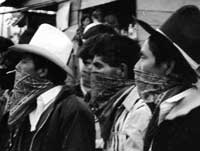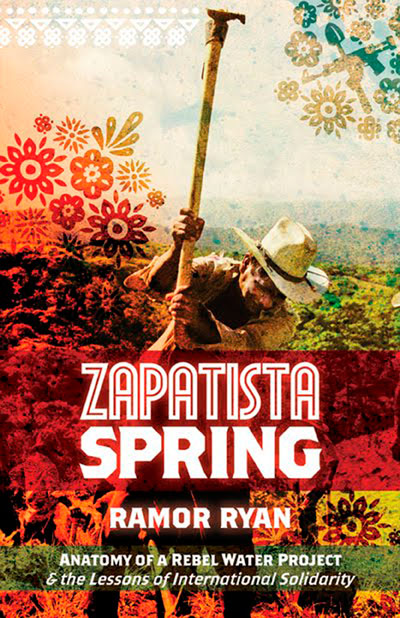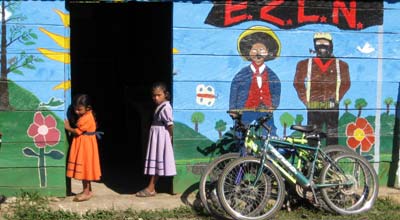Over 30 years of anarchist writing from Ireland listed under hundreds of topics
Zapatista
WSM Points of Unity Explained: 8 - Imperialism
‘8. We oppose imperialism but put forward anarchism as an alternative goal to nationalism. We defend grassroots anti-imperialist movements while arguing for an anarchist rather than nationalist strategy.’
Many places, including Ireland have a history of being occupied by colonial powers and anti-colonial struggles that included a radical element. For instance the role of the Irish Citizen Army, initially set up to protect striking workers from the police, along with James Connolly are well known radical elements within the anti-colonial struggle here. But there are others, as far back as 1798 there were organised groups within the anti-colonial movement that promoted a radical, levelling democracy not just a change of rulers. There were also reactionary elements who wanted a 'free' Ireland to have its own colonies or who supported the slave trade or otherwise advanced white supremacist positions. Nationalism insists on blending all such elements together into a single movement and history in which being Irish erases the difference between radicals and reactionaries of the past and present.
On visiting the Zapatista community of Oventic
Last November, I took part in a week-long language school at Oventic, Chiapas.[1] I spent the week living and learning with two US-based comrades – Laila, a tattoo artist and socialist/feminist from Memphis, and Michael, a housing rights activist from Baltimore – alongside the wider Zapatista community of Oventic. Our ‘guides’ for the week were our neighbours – Natalio and Paloma as well as Stephanie (who was learning to be a teacher) and Efrain (a linguist, philosopher and educator all rolled in to one). These were the people we met and spoke with every day. What follows are some reflections recorded along the way.
Understanding the Zapatistas as a social movement
It is now five years since the EZLN (Zapatista Army of National Liberation) came to the attention of the world when they seized five towns in Chiapas on New Year's day in 1994. The years since have seen only a couple of weeks of actual warfare. However the uneasy cease-fire has seen hundreds of land occupations and several national and international gatherings. Thousands, if not tens of thousands, of people have travelled to Chiapas to see the rebellion with their own eyes. Hundreds have been deported by the Mexican government for doing so. Solidarity groups exist in most western countries, including Ireland. In 1993 Chiapas was as anknown backwater in Mexico. Now, in the eyes of many activists, it has moved to centre stage.
The EZLN rising in Mexico
On New Years Day of '94 people awoke to the news that four towns in the south-eastern state of Chiapas had been taken over by a group calling itself the Zapatista National Liberation Army. Dermot Sreenan, who recently presented a talk on the EZLN and organised a picket of the Mexican embassy in January '94, looks at the politics and history of the EZLN.
Hope, Friendship and Surprise in the Zombie Time of Capitalism: An interview with Gustavo Esteva
Gustavo Esteva is an independent writer and grassroots activist. He has been a central contributor to a wide range of Mexican, Latin American, and international nongovernmental organizations and solidarity networks, including the Universidad de la Tierra en Oaxaca and the Zapatista Army of National Liberation. The WSM's Tom Murray caught up with Gustavo at a recent public lecture at the Kimmage Development Centre to discuss hope, friendship and surprise in the zombie-time of capitalism, and how people are taking initiatives, reclaiming control of their lives and creating vibrant, autonomous alternatives here today.
Occupy Movement, the Zapatista's and the General Assemblies
 The General Assemblies of the Occupy movement are creating a global experience in Direct Democracy. But this model did not come from nowhere - among other sources of influence is the Zapatista rebellion of southern Mexico, soon to enter its 18th year. Over almost two decades hundreds of rebel communities in Chiapas have used a General Assembly model to decide on how all aspects of life in the liberated zone will be organised. Despite their different circumstances to those faced by the majoity of the Occupy camps (in urban built up locations) there is still much that can be learnt from that experience.
The General Assemblies of the Occupy movement are creating a global experience in Direct Democracy. But this model did not come from nowhere - among other sources of influence is the Zapatista rebellion of southern Mexico, soon to enter its 18th year. Over almost two decades hundreds of rebel communities in Chiapas have used a General Assembly model to decide on how all aspects of life in the liberated zone will be organised. Despite their different circumstances to those faced by the majoity of the Occupy camps (in urban built up locations) there is still much that can be learnt from that experience.
This piece written for the Irish Mexico Group by a WSM member a few years after the start of that rebellion looks at how the Zapatistas organise themselves in great detail, what some of the problems they had faced are and how they overcame them. It also looks further into the history of General Assemblies and Direct Democracy in Mexico and around the globe. [Note: This long text is also available as a PDF file in a number of different formats suitable for distribution]
Review: Zapatista Spring
 Editors’ Note: In this issue of the IAR we have the all too rare pleasure of reviewing a book by a fellow Irish anarchist. It’s Ramor Ryan’s Zapatista Spring, one of the most honest books yet published about the Zapatistas.
Editors’ Note: In this issue of the IAR we have the all too rare pleasure of reviewing a book by a fellow Irish anarchist. It’s Ramor Ryan’s Zapatista Spring, one of the most honest books yet published about the Zapatistas.
The Zapatistas and education
 This interview with a Zapatista Educational Promote was carried out in the autonomous and rebel Zapatista community of Morelia, Mexico.
This interview with a Zapatista Educational Promote was carried out in the autonomous and rebel Zapatista community of Morelia, Mexico.
This area of Chiapas have been in rebellion since the 1st of January 1994 and during this time the rebel movement has constructed a new education system. The interviewer is a WSM member who lives outside of Ireland.
A New Direction For The Zapatistas
Over the summer of 2005 the Zapatistas surprised their supporters by suddenly declaring a Red Alert out of the blue. After a couple of days of near panic it emerged that this was just because they were undergoing a consulta (a discussion and referendum) which would decide on a new path for the movement. This new path is to once more turn outwards and to aim to build a new alliance across Mexico and beyond
The Zapatistas and direct democracy
On January 1st 1994, a rebel army called the Emiliano Zapata Liberation Front (EZLN) rose against the Mexican government in Chiapas, Mexico. Workers Solidarity contributor Andrew Flood has been researching the life of ordinary people in the Zapatista area. Below he writes about some of his findings

